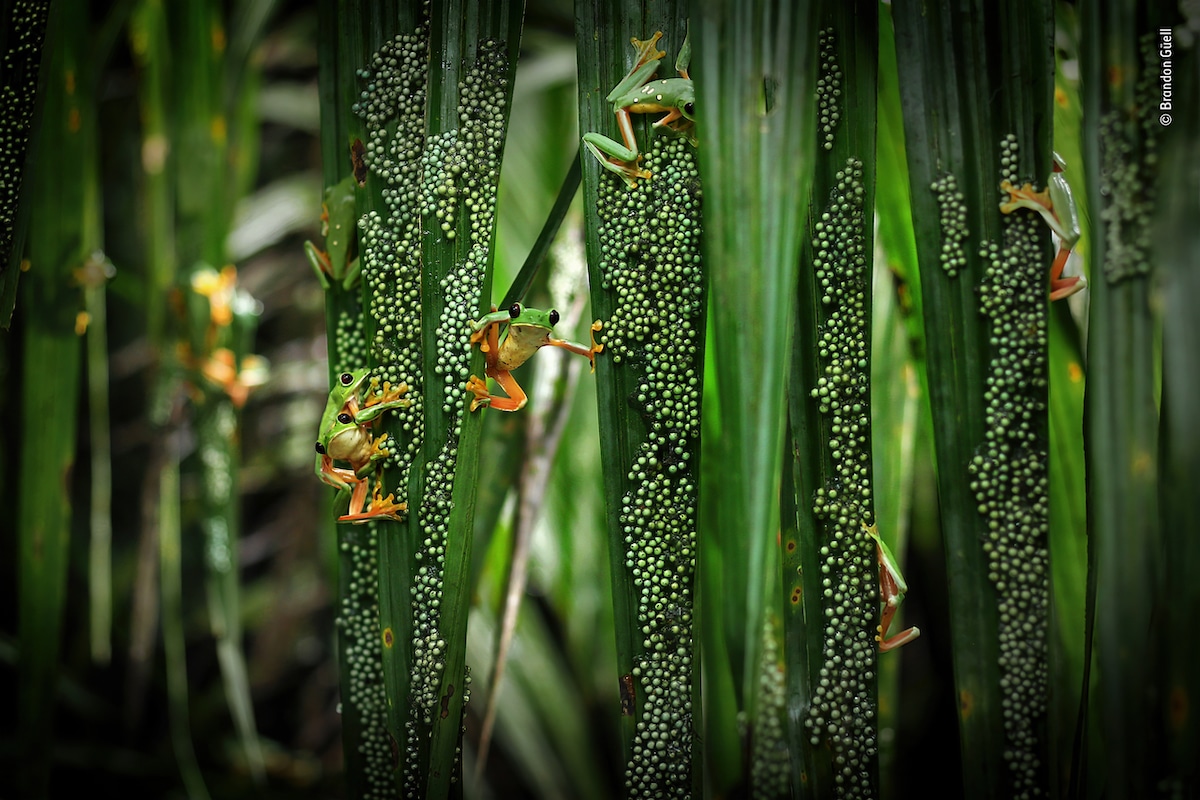
“Treefrog pool party” by Brandon Güell, Costa Rica/USA. Highly commended, Behavior: Amphibians and Reptiles
Location: Osa Peninsula, Puntarenas, Costa Rica
“Plagued by mosquitoes, Brandon waded chest-deep into the murky water where a gathering of male gliding treefrogs were calling. At dawn thousands of females arrived at the pool to mate and lay their eggs on overhanging palm fronds. Here, unmated males search for females to mate with.
These spectacular mass-breeding events occur in only a few remote locations, a few times a year. Each female lays around 200 eggs, creating huge egg masses. Eventually the tadpoles will drop into the water below.”
Since 1965 the Wildlife Photographer of the Year competition has been spotlighting global talent and giving the public an inside look at animals around the world. In anticipation of the announcement of this year’s winners, the contest has released a sneak preview of select images that are highly commended in their categories. The stellar images show us everything from a treefrog mating party to a polar bear hanging out in an abandoned house to an octopus hiding in a clam shell.
If the quality of these highly commended images is any indication, this year’s contest winners will be top-notch. The 15 highlighted images are just a fraction of the 100 winning and finalist photographs that will be announced in full in October. Each entry was judged anonymously on its creativity, originality, and technical excellence by an international panel of industry experts.
Photographers of all age ranges and experience were invited to submit their best wildlife photographs. For the 2022 photo contest, 93 countries were represented and had images entered into categories like Animal Portraits, Behavior, and Urban Wildlife. As always, journalistic storytelling is also valued. Dutch photojournalist Jasper Doest saw his portrait of a river manager in Zambia singled out. The photo is part of a larger story detailing the conservation of wetlands in the area.
While many of the photographs, such as Dmitry Kokh’s portrait of a polar bear, are whimsical, several share an important message. For Canadian photographer Jo-Anne McArthur, showing animal cruelty is an important part of her work and is necessary to instigate change. Her shortlisted photo of poor conditions at a Swedish mink farm is difficult to look at, but necessary for the public to see.
Honoring such a wide variety of work is critical for the contest, which is managed by the Natural History Museum, London. “What’s stayed with me is not just the extraordinary mix of subjects in this year’s collection—a vast panorama of the natural world—but the emotional strength of so many of the pictures,” shared judging panel chair Roz Kidman Cox.
Enjoy this preview and mark your calendars for October 11, when all the finalists and winners will be revealed during an exclusive awards ceremony. The Natural History Museum will then unveil the brand new, redesigned Wildlife Photographer of the Year exhibition on October 14, 2022 in London.
Take a look at some of the finalists of the 2022 Wildlife Photographer of the Year contest.
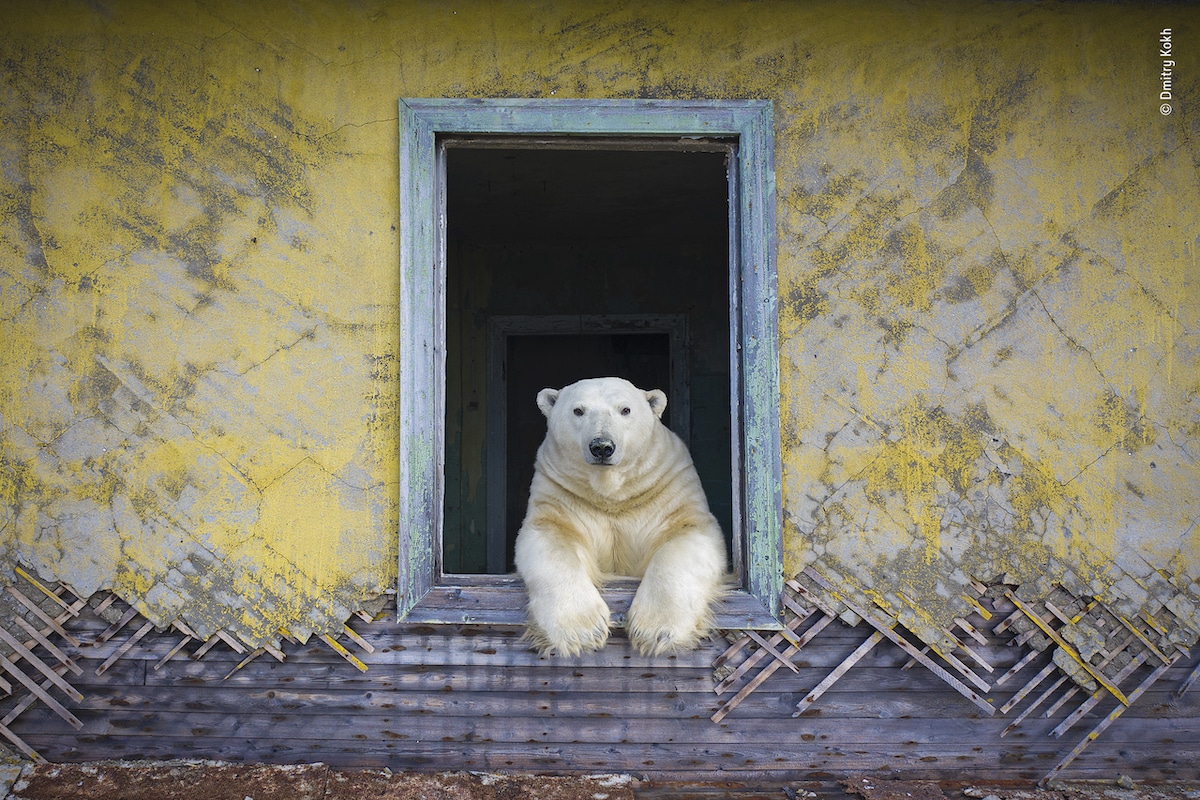
“Polar frame” by Dmitry Kokh, Russia. Highly commended, Animal Portraits.
Location: Kolyuchin Island, Chukotka, Russia
“When Dmitry’s boat approached the small island of Kolyuchin, in the Russian High Arctic, which had been abandoned by humans since 1992, he was surprised to spot movement in one of the houses. Binoculars revealed polar bears—over 20 in total—exploring the ghost town. Dmitry used a low-noise drone to document the surreal experience.
Extremely inquisitive, polar bears will investigate abandoned structures for potential food. With climate change reducing sea ice, hunting is becoming increasingly difficult, pushing these bears closer to human settlements to scavenge.”
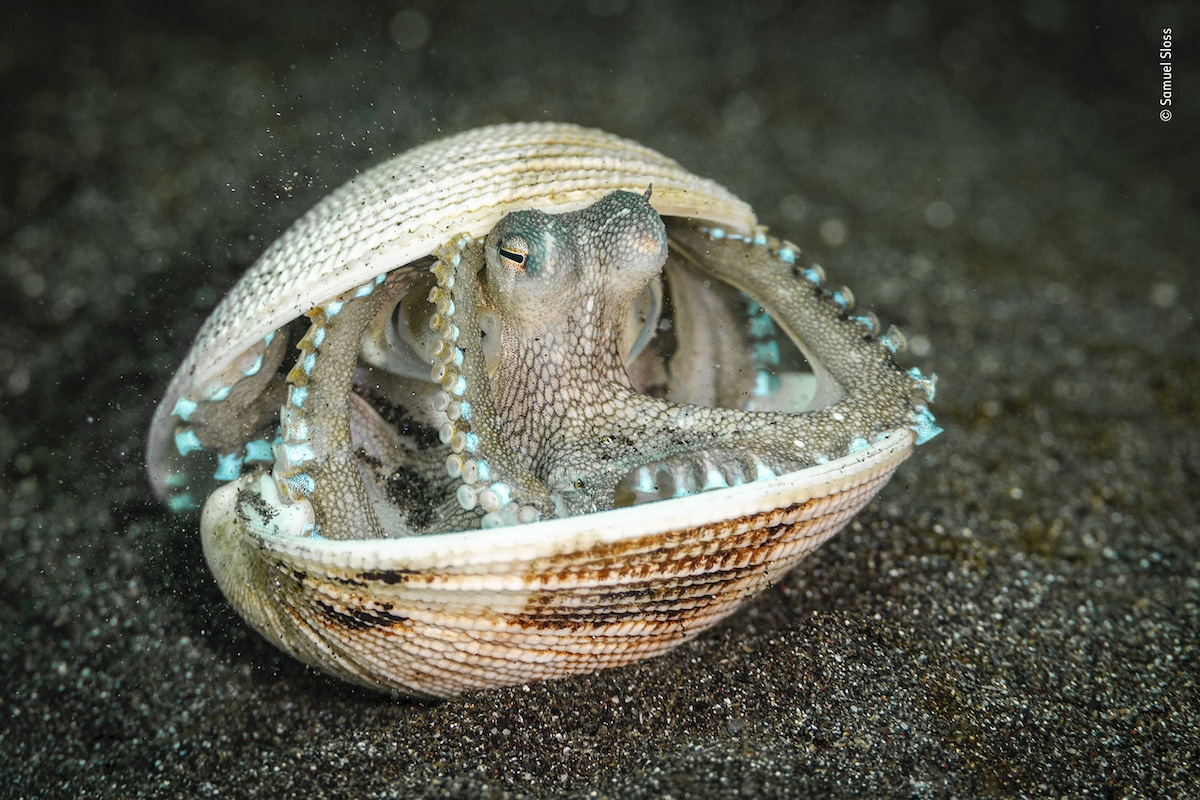
“The octopus case” by Samuel Sloss, Italy/USA. Highly commended, 15-17 Years.
Location: Lembeh Strait, Sulawesi, Indonesia
“Samuel was muck diving when he noticed this octopus. He lowered the power of his strobe lamp so as not to distress it. The octopus shut the lid of the shell when Samuel approached, but then slowly opened it, revealing colors and coils.
This small octopus hunts mainly shrimps, crabs, clams and small fishes. To protect its soft body when foraging on sand or mud, it hides in various objects—sometimes even coconut shells.”
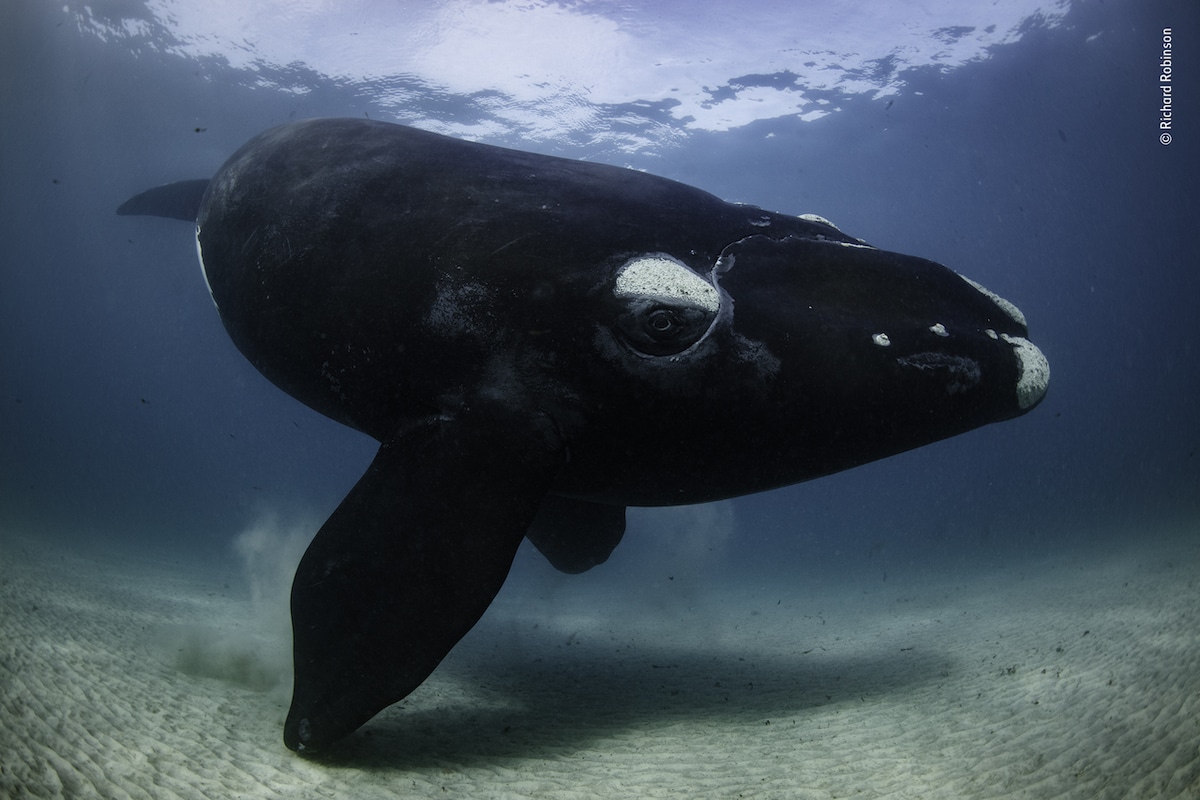
“The right look” by Richard Robinson, New Zealand. Highly commended, Animal Portraits.
Location: Port Ross, Auckland Island, New Zealand
“With the whale investigating him, Richard’s main challenge was to swim far enough from the curious calf to photograph it. The encounter lasted 30 minutes, with the whale circling him, swimming off, then returning for another look.
New Zealand’s population of southern right whales, known as ‘tohorā’ in Māori, were hunted to near extinction by European whalers in the 1800s, then by Soviet whalers in the 1900s. Now protected, the population has bounced back from a small group including just 13 breeding females, to more than 2,000 individuals.”
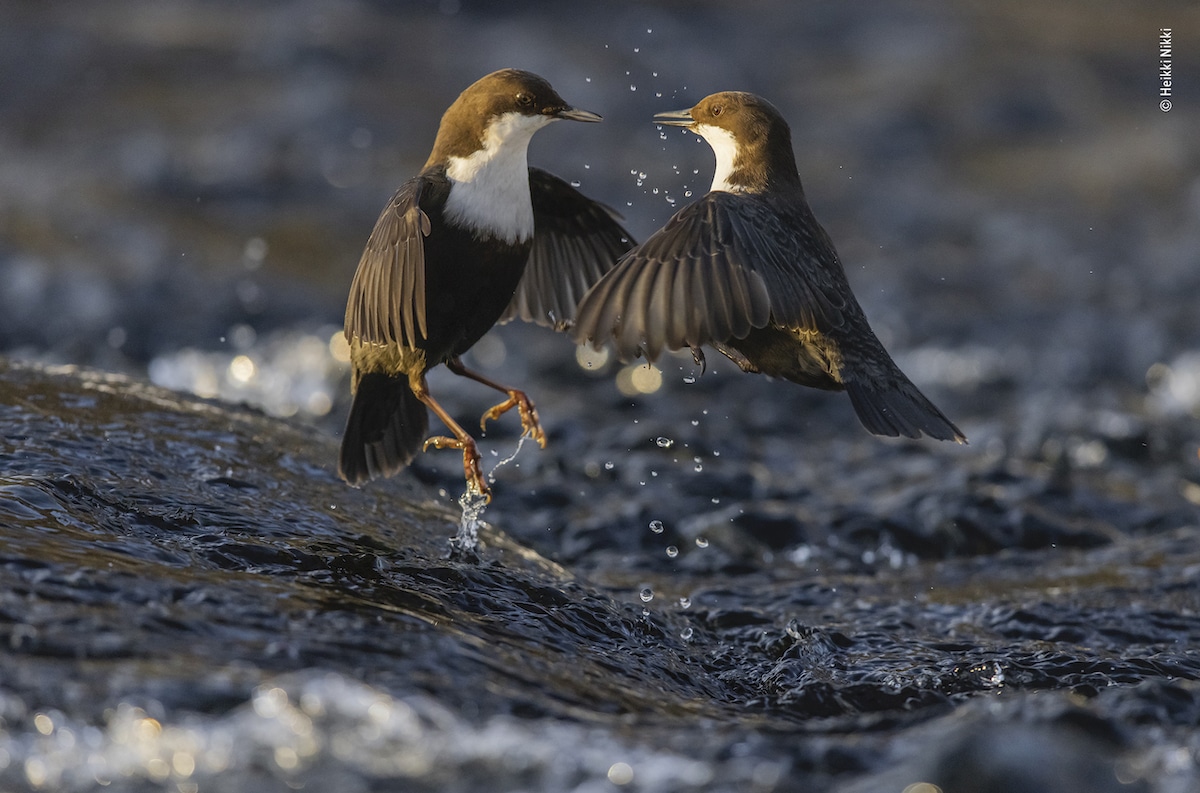
“Dipper dispute by Heikki Nikki, Finland. Highly commended, Behavior: Birds.
Location: Kuusamo, North Ostrobothnia, Finland
“After years of visiting the river, Heikki knew every ‘dipping’ rock favored by white-throated dippers. Picking one hidden beneath flowing water, he sat quietly on the bank. Suddenly the spot became the subject of a hotly contested argument. Poised for the action, Heikki captured the fleeting moment.
Dippers use ‘dipping’ rocks as a launch pad to scout rivers before diving down to hunt mayfly and caddisfly larvae and small fish, swallowing tiny catches while submerged.”

“The disappearing giraffe by Jose Fragozo, Portugal. Highly commended, Natural Artistry.
Location: Nairobi National Park, Kenya
“Keeping his camera steady in the moving vehicle, Jose followed the giraffe. Dwarfed by the giant pillars of Kenya’s new Standard Gauge Railway, the grey blocks contrast with the unmistakable pattern of nature’s tallest land mammal.
Around the world, human development increasingly encroaches on the range and habitats of animals. Though this stretch of railway running through Nairobi National Park is raised on giant columns, allowing animals access beneath, this picture is symbolic of how the space for wildlife continues to be squeezed.”
Wildlife photographers from 93 countries entered their best work into the prestigious contest.
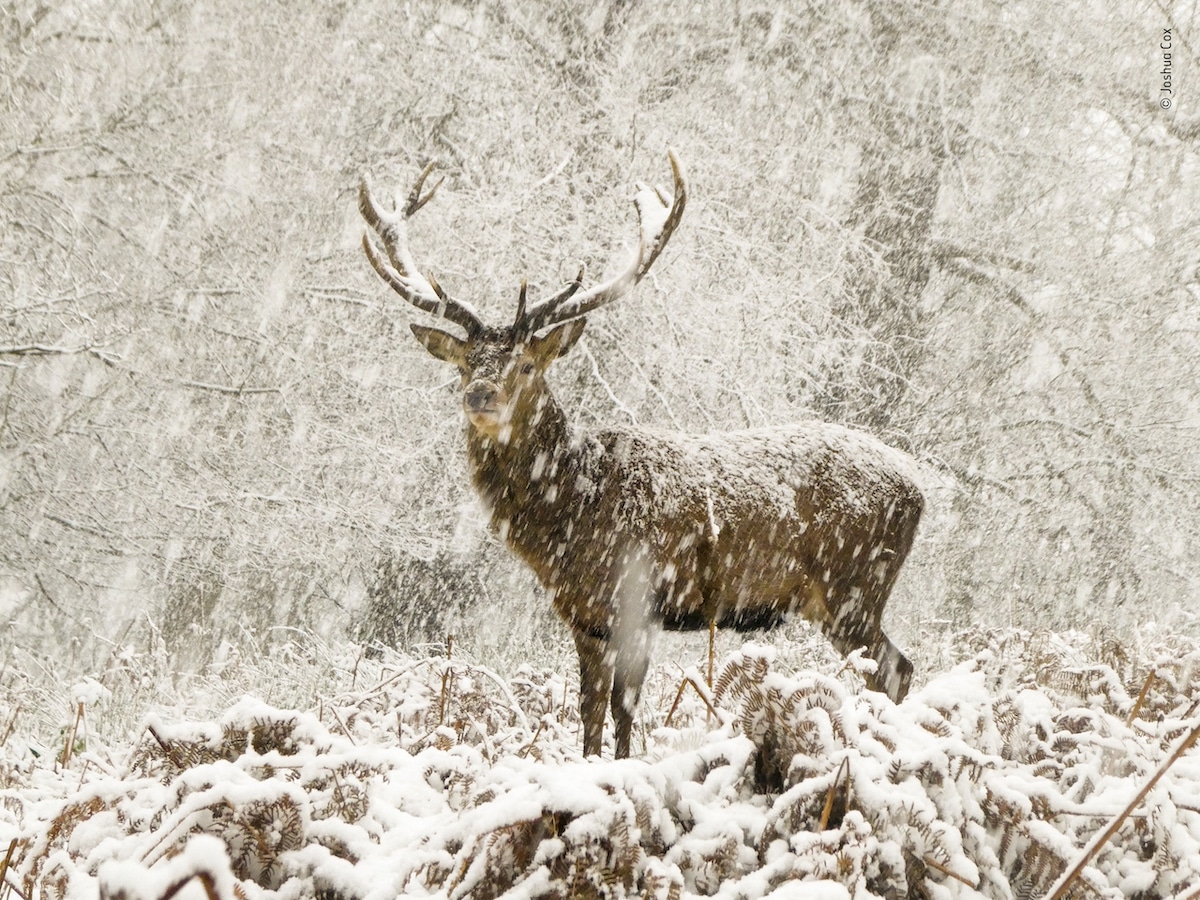
“The snow stag” by Joshua Cox, UK. Highly commended, 10 Years and Under.
Location: Richmond Park, London, UK
“It had just started to snow when Joshua and his father arrived in Richmond Park. They followed the deer at a safe distance when suddenly the snow intensified and one of the stags stopped. ‘He almost looked as if he was having a snow shower,’ says Joshua.
Richmond Park is home to herds of red and fallow deer, which have been roaming freely since 1637. The grazing deer help to manage the landscape of the park.”

“Underwater wonderland” by Tiina Törmänen, Finland. Highly commended, Under Water.
Location: Posio, Finland
“Tiina was thrilled to meet a school of inquisitive European perch on her annual lake snorkel. During the previous three years, she had only ever found dead fish. Submerged in the surreal scene, she framed the orange-finned fish flying through clouds of pink-tinged algae.
Although it created a beautiful scene, excessive algal growth, a result of climate change and warming waters, can cause problems for aquatic wildlife as it uses up oxygen and blocks out sunlight.”
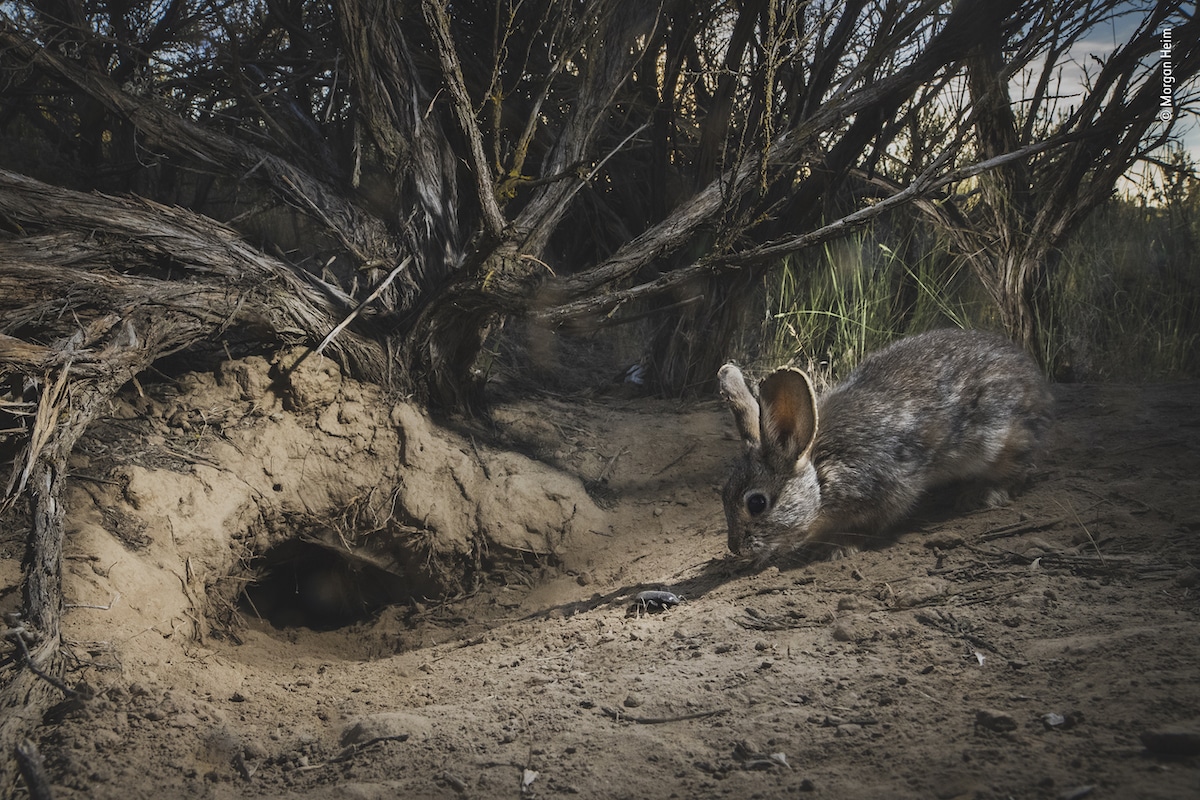
“Burrow mates” by Morgan Heim, USA. Highly commended, Animals in their Environment.
Location: Near Quincy, Washington, USA
“Morgan Heim reveals an intimate encounter between a beetle and a rabbit.
Morgan set up camera traps by the active burrows of pygmy rabbits in the Columbia Basin to observe their comings and goings. She was delighted by this moment of interaction as one of the rabbits sniffed at a stink beetle that had been sheltering in its burrow.
These rabbits live in Washington state’s Columbia Basin. The Basin has become increasingly overgrazed, and parts have been cleared for crop growing. With this small, isolated population facing extinction, conservationists have intervened, boosting numbers to 150 and rising.”
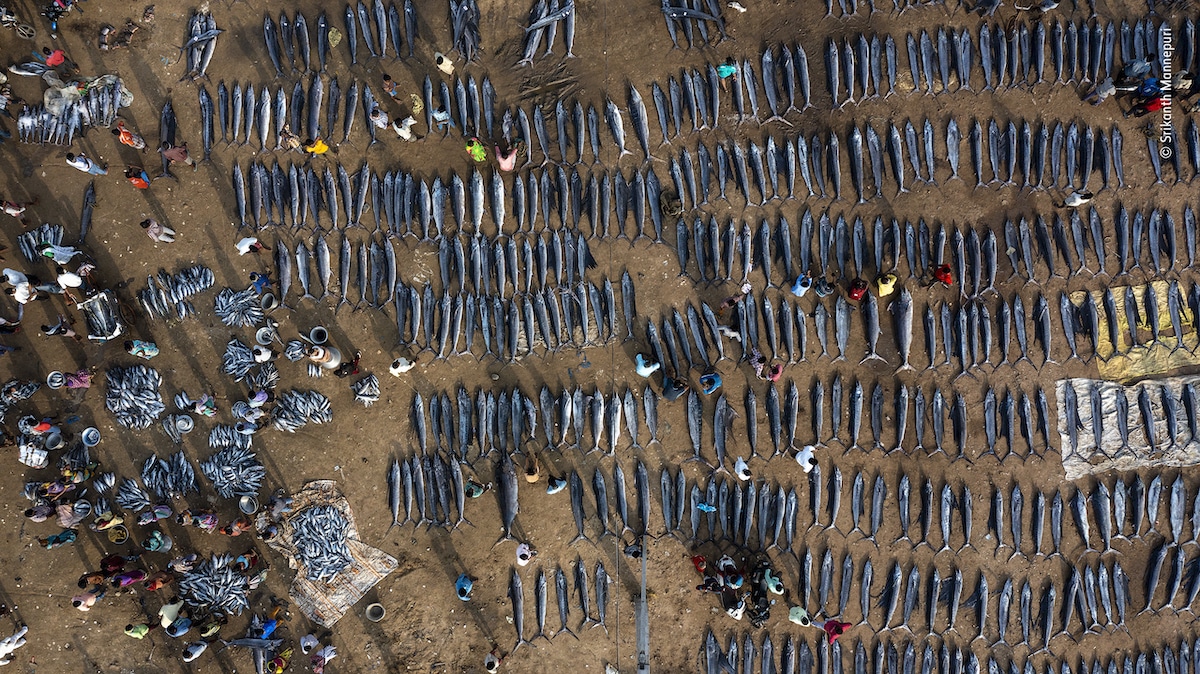
“Just one day’s catch” by Srikanth Mannepuri, India. Highly commended, Oceans: The Bigger Picture.
Location: Kakinada, Andhra Pradesh, India
“Srikanth Mannepuri takes a sobering look at the scale of unsustainable fishing.
Srikanth was shocked to see so many recently caught marlin and sailfish in a single place in one morning. To demonstrate the scale of the fish market, he used a drone to take the image from a bird’s-eye view.
Sailfish and marlin are top ocean predators essential to ecosystems. Globally, 85% of fish stocks are currently overexploited by humans. Without urgent efforts to protect marine habitats and create truly sustainable fishing practices, we will soon begin to lose species forever.”

“Sloth dilemma” by Suzi Eszterhas, USA. Highly commended, Urban Wildlife.
Location: Puerto Viejo de Talamanca, Costa Rica
“Suzi Eszterhas captures an encounter between a sloth and a dog.
The brown-throated sloth had already made it across a road, but to reach the next clump of trees it needed to return to the ground and crawl. Meeting a big dog, it froze. Suzi watched fearfully but the dog, having taken part in a sloth-safety training program with Sloth Conservation Foundation, simply sniffed it.
Sloths live in trees and rarely descend to the forest floor. With increasing habitat loss and the fragmentation of the forest, they are forced on vulnerable journeys across urbanized areas to find food, suitable habitats and mates.”
The winners will be announced on October 11 during an exclusive awards ceremony.
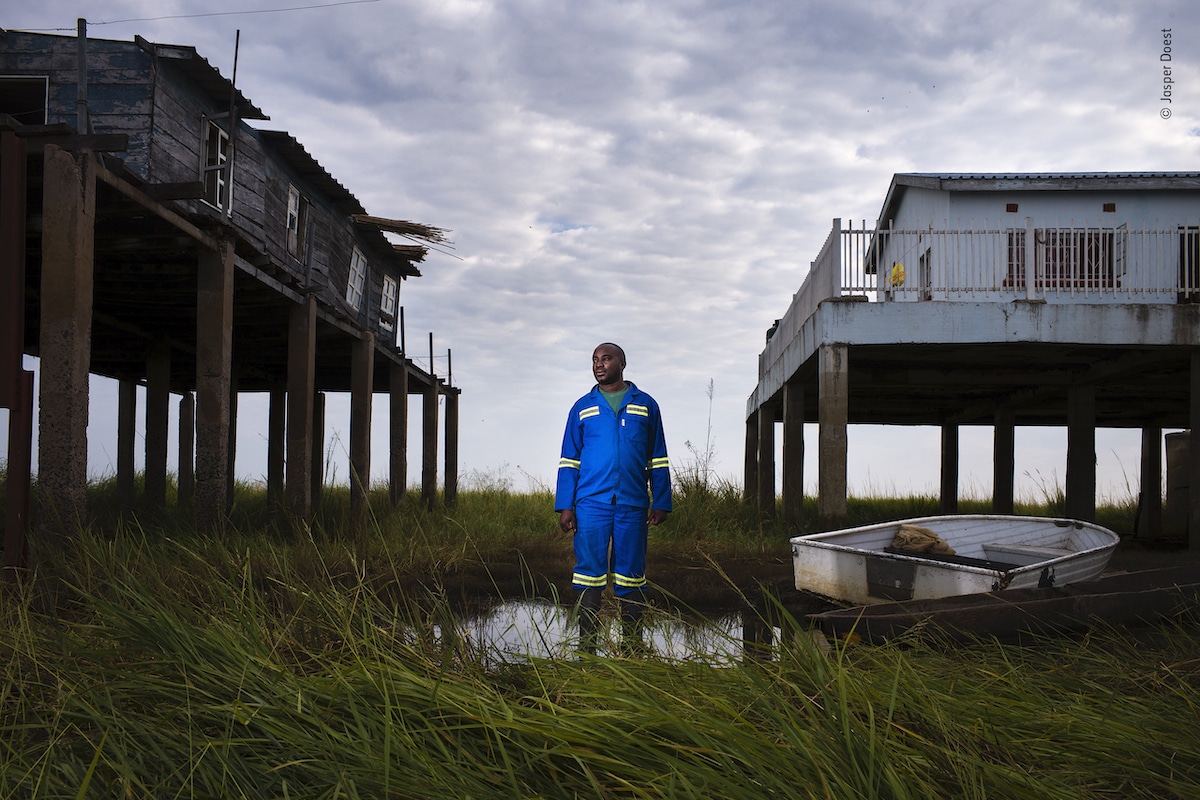
“The lost floods” by Jasper Doest, The Netherlands. Highly commended, Wetlands – The Bigger Picture.
Location: Barotse Floodplain, Zambia
“Lubinda Lubinda is station manager for the Zambezi River Authority. Lower water levels mean his new house (right) did not need to be built as high. Climate change and deforestation mean the Barotse people of the floodplain are subject to more frequent droughts.
A diversity of wildlife is dependent on regular floods, as is the Barotse people’s way of life. The wetland provides people with fish, pasture for livestock, fertile soil, and vegetation for thatching and making household items.”
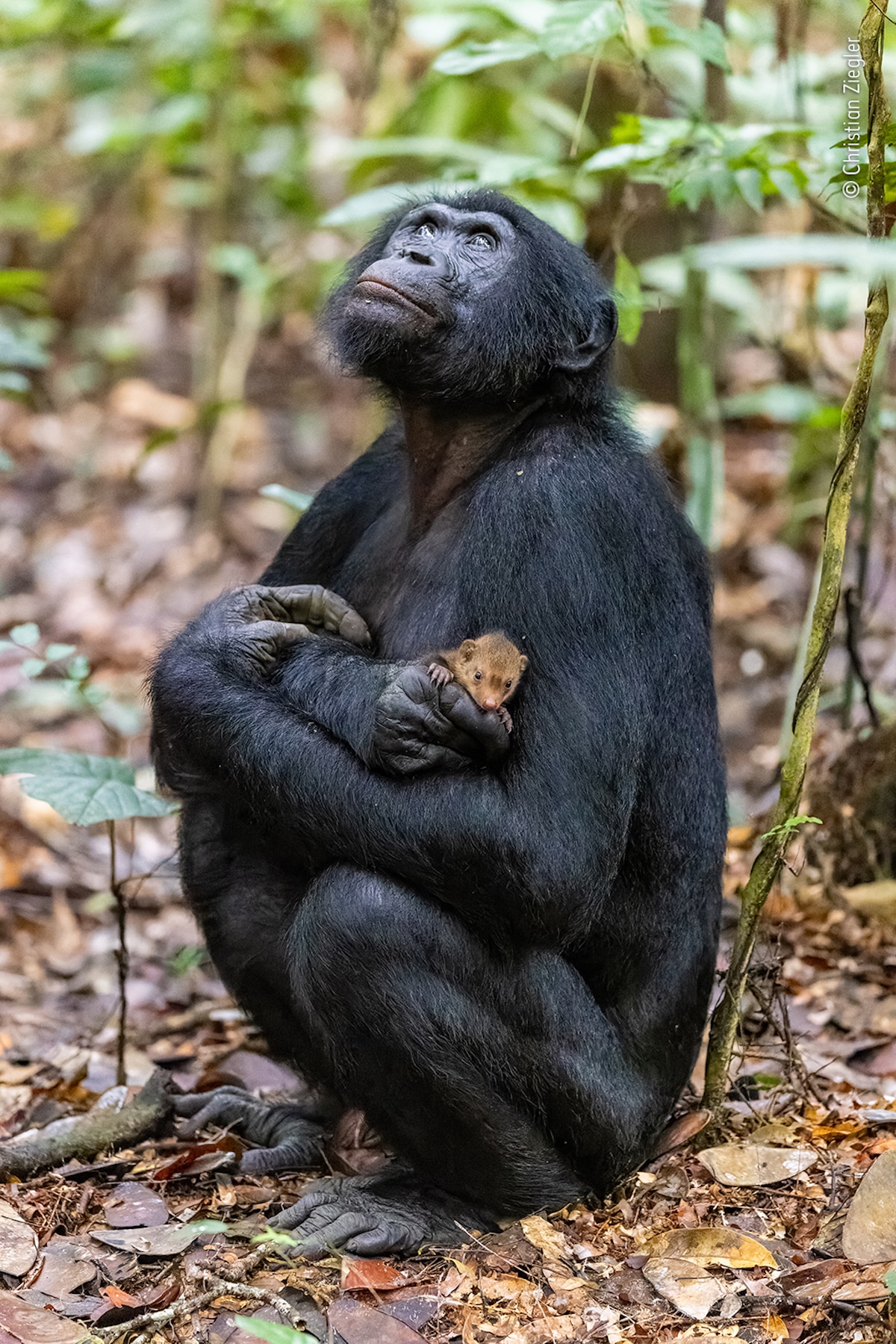
“The bonobo and the mongoose by Christian Ziegler, Germany. Highly commended, Behavior: Mammals.
Location: LuiKotale field site, near Salonga National Park, Democratic Republic of the Congo.
“Christian was tracking a group of these endangered great apes that are being studied by Barbara Fruth of the Max-Planck Society. He recalls setting out ‘before light’, wading ‘chest-deep through flooded forest’, and frequently walking 20 kilometers (12 miles) a day. ‘The bonobo held and stroked the little mongoose for more than an hour.’
The situation probably had a darker beginning. Bonobos are omnivores and eat mainly fruit but occasionally they hunt. The mongoose pup – eventually released unharmed – may have been taken when its mother was killed.”
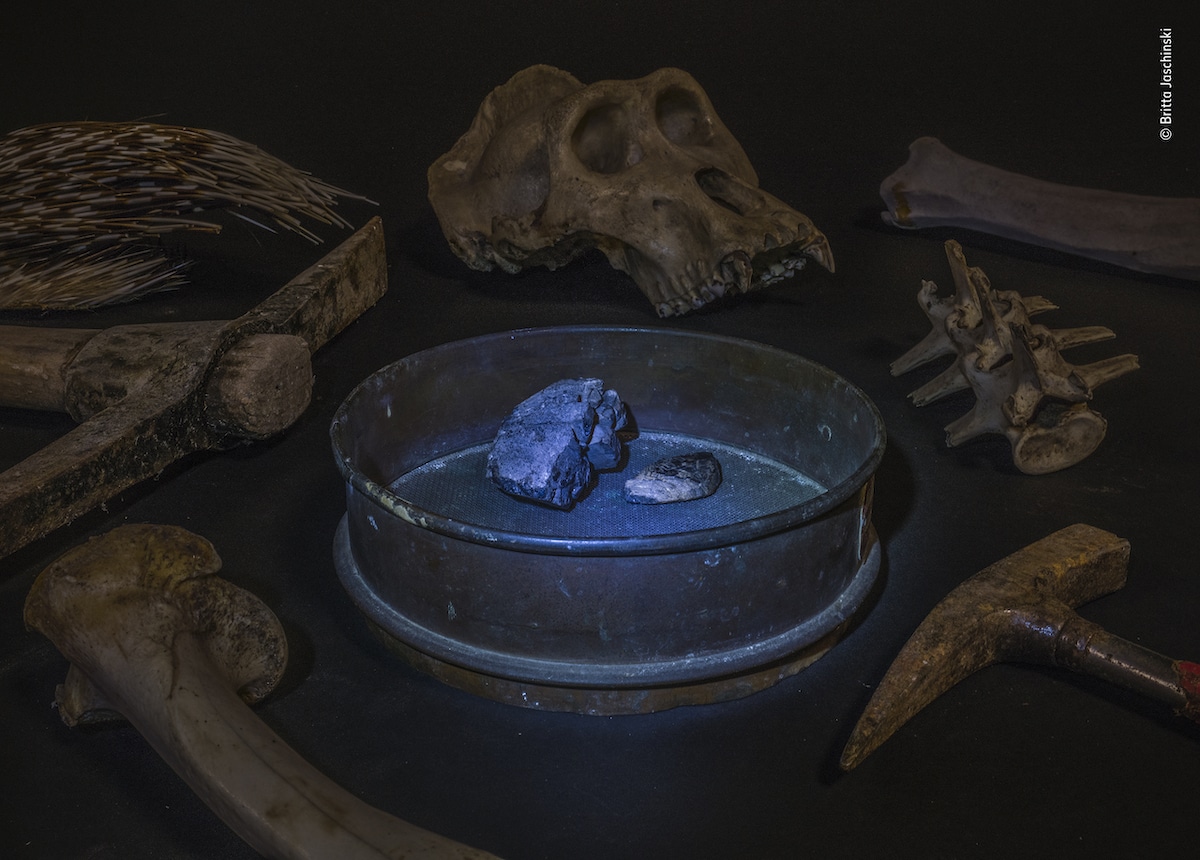
“Wanted!” by Britta Jaschinski, Germany/UK. Highly commended, Photojournalism.
Location: Leibniz Institute for the Analysis of Biodiversity Change, Hamburg, Germany.
“Glowing blue, coltan is a component of phone and laptop batteries. Here, Britta surrounds it with mining tools and the remains of animals impacted by the industry, all seized by customs authorities: a gorilla skull, vertebrae and leg bone, and porcupine quills.
Coltan is extracted from the riverbeds of the Democratic Republic of the Congo by poorly paid miners who hunt wild animals for food. Hunting and trading wildlife threatens the future of the country’s gorillas and has led to an increased risk of viruses jumping to humans.”
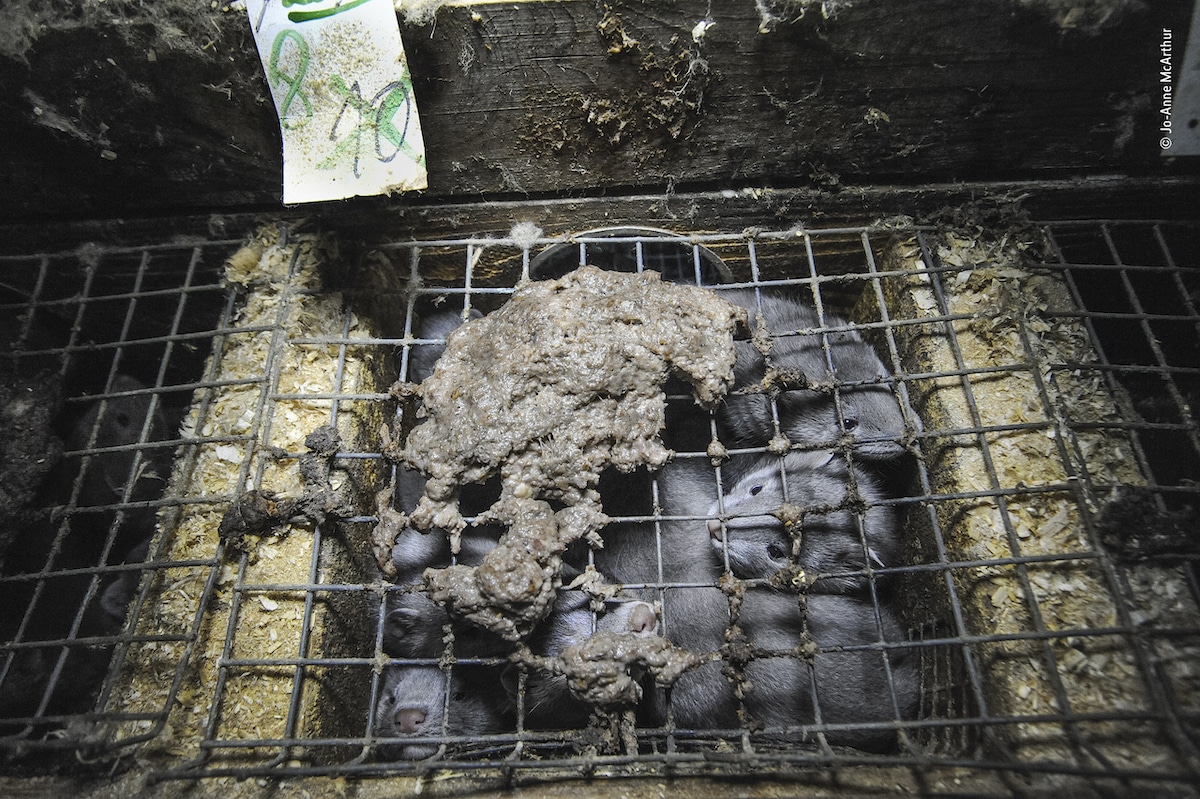
“Life and death in fur farming” by Jo-Anne McArthur, Canada. Highly commended, Photojournalism
Location: Lindasen, Sweden
“For Jo-Anne it is important to document cruelty in order to instigate change. At a Swedish mink farm, the sign above a cramped, inhospitable cage indicates two kits have died. Due to legislation changes since this photo was taken, farms now have slightly larger cages, but the standard of life remains poor.
In 2020 scientists discovered that mink could catch the Covid-19 virus and that it could mutate and be transmitted to humans. In response, Denmark shut down its industry. In 2022 in Sweden, after a temporary ban on breeding, the government allowed some mink farms to reopen.”
